| |
Three Years of Continuous Treatment in Chinese Patients who had Previously Failed Lamivudine: Results from Studies ETV-056 and ETV-050
|
| |
| |
Reported by Jules Levin
This data was presented today at 18th Conference of the Asia-Pacific Association for the Study of the Liver (APASL) in Seoul, Korea.
GB Yao1, DZ Xu2, H Ren3, XQ Zhou4, JD Jia5, YM Wang6, CW Chen7, J Liu8, D Xu9 and C Llamoso9
1Shanghai Jing An Qu Central Hospital, Shanghai, China; 2Beijing Di Tan Hospital, Beijing, China; 3No. 2 Hospital Affiliated to Chongqing Medical University, Chongqing, China; 4Ruijin Hospital, Shanghai, China;
5Beijing Friendship Hospital, Beijing, China; 6Southwest Hospital Affiliated to 3rd Military Medical University, Chongqing, China; 7Shanghai Liver Disease Center of Nangjing Military Command, Shanghai, China; 8Bristol-Myers Squibb Company Research and Development, Braine-l'Alleud, Belgium; 9Bristol-Myers Squibb Company Research and Development, Wallingford, CT, USA
Author Conclusions
Lamivudine-refractory patients treated continuously with entecavir 1 mg daily through 3 years achieved:
- HBV DNA suppression to less than 300 copies/mL which increased from 30% at Week 48 to 55% at Week 144
- ALT normalization in 65% of patients
Long-term treatment with ETV was safe and well tolerated, with a safety profile consistent with previously reported experience
Introduction
· Lamivudine-refractory Chinese patients with chronic hepatitis B (CHB) treated with entecavir (1 mg daily) demonstrated marked HBV DNA reductions and normalization of ALT in study ETV-0561
· In ETV-056, patients were randomized to receive either entecavir (1 mg daily) or placebo for 12 weeks, followed by 36 weeks of open-label entecavir treatment1
· All patients who completed the 36-week open-label phase of ETV-056 (treatment with entecavir 1 mg daily) and who were assessed as likely to benefit from additional therapy were eligible to continue entecavir treatment (1 mg daily) in rollover study ETV-050
· We present efficacy and safety results for a cohort of lamivudine-refractory Chinese patients who received up to 3 years of treatment with entecavir 1 mg daily in studies ETV-056 and -050
Chinese long-term lamivudine (LVD)-
refractory entecavir (ETV) cohort
The Chinese long-term LVD-refractory ETV cohort consists of 138 patients initially treated in ETV-056 who:
- had previously failed lamivudine treatment and completed at least 36 weeks of entecavir 1 mg daily in study ETV-056
- enrolled in ETV-050 with a <35-day gap in treatment* between the last dose in ETV-056 and the first dose in ETV-050
*None of the patients in this cohort had a treatment gap
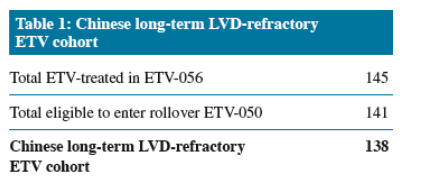
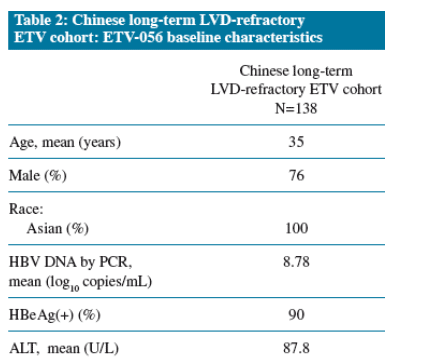
Patient management in ETV-050
Patients who achieved a Complete Response* during treatment stopped study drug and were followed off-treatment for 24 weeks
* Defined as HBV DNA <104 copies/mL by PCR and HBe seroconversion in patients who were HBeAg(+) at baseline; HBV DNA <104 copies/mL and ALT < 1.25 x ULN in patients who were HBeAg(-) at baseline.
By Week 144, 31 patients (22%) from this long-term LVD-refractory ETV cohort achieved a Complete Response and stopped entecavir treatment
Chinese long-term LVD-refractory ETV cohort: evaluations
Proportion of the Chinese long-term LVD-refractory ETV cohort (n=138) with:
- undetectable HBV DNA (<300 copies/mL)*
- ALT normalization (ALT <1 x ULN)*
- HBeAg loss*
- HBe seroconversion (loss of HBeAg, gain of anti-HBe)*
· Genotypic resistance testing was not performed in this study
In patients with available samples
In patients with ALT > 1.0 x ULN at baseline
In patients who were HBeAg-positive at baseline
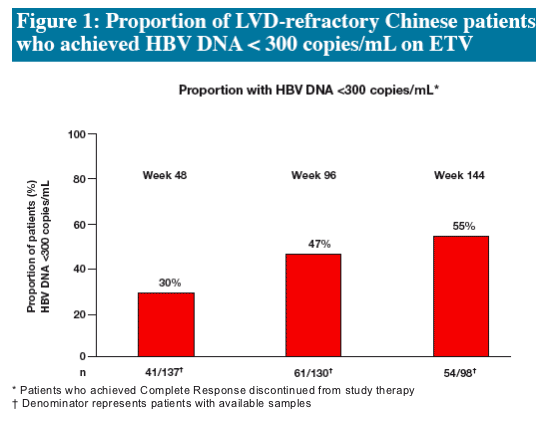
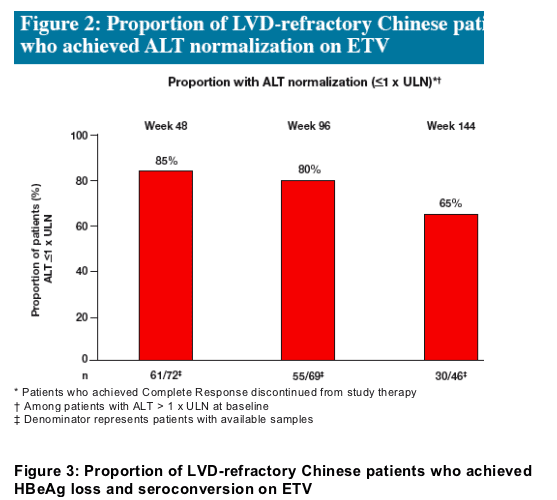

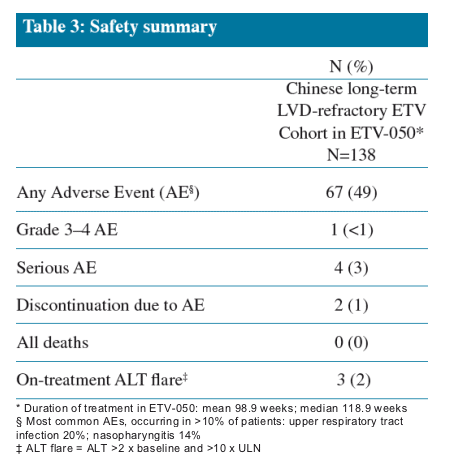
References
1. Yao G, et al. Hepatol Int 2007;3:373-381.
|
|
| |
| |
|
|
|